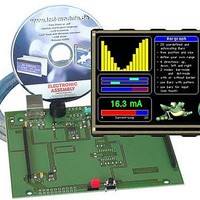EA STARTEDIPTFT4 ELECTRONIC ASSEMBLY, EA STARTEDIPTFT4 Datasheet - Page 7

EA STARTEDIPTFT4
Manufacturer Part Number
EA STARTEDIPTFT4
Description
TFT Displays & Accessories Starter/Demoboard w/Touch USB prog
Manufacturer
ELECTRONIC ASSEMBLY
Datasheet
1.EA_EDIPTFT43-A.pdf
(28 pages)
Specifications of EA STARTEDIPTFT4
Attached Touch Screen
Yes
Background Color
White
Interface
I2C, SPI, RS-232
Interface Type
RS-232, I2C, SPI
Maximum Operating Temperature
+ 70 C
Minimum Operating Temperature
- 20 C
Operating Temperature Range
- 20 C to + 70 C
Supply Voltage
5 V
Touch Panel
Touch Panel
Viewing Area (w X H)
53.86 mm x 95.04 mm
Module Size (w X H X T)
71 mm x 107 mm x 12 mm
Backlighting
LED
Lead Free Status / RoHS Status
Lead free / RoHS Compliant
ELECTRONIC ASSEMBLY reserves
the right to change specifications
without prior notice. Printing and
typographical
I²C-BUS INTERFACE
If the display is wired as shown
below, it can be operated
directly on an I²C bus.
8 different base addresses and
8 slave addresses can be
selected on the display.
Data transfer is possible at up
to 100 kHz. However, if pauses
of at least 100 µs are
maintained between the
individual
transfer, a byte can be
transferred at up to 400 kHz.
Note:
The pins BA0 to 2, SA0 to 2, DPOM, DPROT and TEST/SBUF have an internal pullup, which is why only the LO level
(L=0=GND) is to be actively applied. These pins must be left open for a Hi level (H=1).
On pin 20 (SBUF) the display indicates with a low level that data is ready to be retrieved from the internal send buffer.
The line can be connected to an interrupt input of the host system, for example.
DATA TRANSFER I²C-BUS
principle I2C-bus transfer:
Read operation: for internal operation the
EA eDIP does need a short time before providing
the data; therefore a short pause of min. 6µs is
needed for each byte (no activity of SCL line).
- I²C-Start
- Master-Transmit: EA eDIP-I²C-address (e.g. $DE), send smallprotocol package (data)
- I²C-Stop
- I²C-Start
- Master-Read: EA eDIP-I²C-Address (e.g. $DF), read ACK-byte and opt. smallprotocoll package (data)
- I²C-Stop
errors
bytes
reserved.
during
Pin Symbol In/Out Function
10
11
12 I2CMO
13 DPOM
14
15
16
17 DPROT
18
19
20
1
2
3
4
5
6
7
8
9
RESET
BUZZ
TEST
SBUF
GND
VDD
SDA
DNC
BA0
BA1
SA0
SA1
SA2
BA2
SCL
WP
NC
NC
Bidir. Serial Data Line
Out
Out
Out
IN
In
In
In
In
In
In
In
In
In
In
In
In
Ground Potential for logic (0V)
Power supply for logic (+5V)
do not connect
do not connect
L: Reset
Basic Address 0
Basic Address 1
Slave Address 0
Slave Address 1
Slave Address 2
Basic Address 2
connect to GND for I²C interface
L: disable PowerOnMacro
do not connect for normal operation
Serial Clock Line
Buzzer output
L: Disable Smallprotokoll
do not connect for normal operation
L: internal, do not connect
L: Writeprotect for DataFlash
open-drain with internal pullup 20..50k
IN (Power-On) L: Testmode
OUT L: data in sendbuffer
Pinout eDIPTFT43-A: I2C mode
BA2 BA1 BA0
H
H
H
H
L
L
L
L
Pin 11,7,6
Pin
21
22
23
24
25
26
27
28
29
30
31
32
33
34
35
36
37
38
39
40
H
H
H
H
L
L
L
L
OUT1 / MO8
OUT2 / MO7
OUT3 / MO6
OUT4 / MO5
OUT5 / MO4
OUT6 / MO3
OUT7 / MO2
OUT8 / MO1
EA eDIPTFT43-A
IN1 / MI8
IN2 / MI7
IN3 / MI6
IN4 / MI5
IN5 / MI4
IN6 / MI3
IN7 / MI2
IN8 / MI1
H
H
H
H
L
L
L
L
Symbol
AIN1
AIN2
GND
VDD
address
Base
$D0
$10
$20
$30
$40
$70
$90
$B0
I²C - Address
In/Out Function
Out
In
In
application example
D7
0
0
0
0
0
1
1
1
Ground (0V)
Power supply (+5V)
analogue input 0..5V
DC impedance 1MOhm
8 digital outputs
maximum current:
IOL = IOH = 10mA
alternativ up to 8 matrix
keyboard output lines
(reduces the digital
output lines, see chapter
external keyboard)
8 digital inputs
open-drain with internal
pullup 20..50k
alternativ up to 8 matrix
keyboard input lines
(reduces the digital input
lines, see chapter
external keyboard)
all pins open: Write $DE
D6
0
0
0
1
1
0
0
1
D5
0
1
1
0
1
0
1
0
I²C address
D4
1
0
1
0
1
1
1
1
D3
S
A
2
Page 7
Read $DF
D2
S
A
1
D1
S
A
0
W
D0
R




















